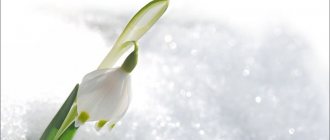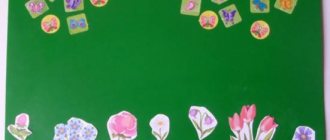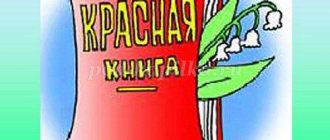Competitive presentation “Animals of the North”
Summary of a lesson for children of the senior group on the topic: “Animals of the North” (integration of OO “Communication”, “Cognition”, “Physical Education”) Program content: 1. Introduce children to the features of the natural conditions of the Far North. 2. Give an idea of how animals are adapted to harsh living conditions. 3. Instill a love for animals. 4. To consolidate ideas about types of transport and their features, the ability to find the missing number, connect the dots in order. Equipment: Projector, screen, presentation “Animals of the North”, CD with the song “Bear Lullaby”, handout sheets with dots to connect in order, pencils for each child. Previous work: conversation about the North, looking at an album with illustrations, encyclopedias, reading fiction. The teacher invites the children to go on a trip to the North. Includes slide 2 Educator: Children, look at the slide, what types of transport do you see? What can we use to get to the North the fastest? Why? Prove it. (Children's answers) Educator: I agree with you. Let's go on a trip! Includes slide 3 Physical exercise Hands to the sides - we send the plane into flight. Right wing forward, left wing forward. One, two, three, four - our plane flew. Includes slide 4. Educator: So we landed. This is the harsh and cold north. There is snow and ice all around. What kind of weather do you think happens here most often? (Children's answers) Tell me, is it easy for people and animals to live in such conditions? (Children's answers) Includes slide 5 Educator: Guys, do you want to know what animals live in the North? Listen to the riddle: This white giant weighs many kilograms He will float on an ice floe, Find fish for dinner (Polar bear) Includes slide 6 Educator: Does he look like a brown bear? How? (Same paws, same big.) What is the difference between a polar bear and a brown bear? (The color of the coat is white, the polar bear loves water, swims easily, lives in the North.) Children, who do you think likes to swim in water more: a polar bear or a brown one? (Children's answers.) What kind of fur does a polar bear have? (Thick, warm, so in the most severe frost he is not cold). Includes slide 7 Educator: Polar bears live far away - far in the North in the Arctic Ocean. In winter and summer, huge ice floes float on the ocean, they float slowly, and all around there is water and water and the shore is not visible. It seems that no animal can live there. A polar bear crawls out of the water onto an ice floe, shakes itself off - and is dry again, do you want to know why? To understand how the bear adapted to such conditions, let’s do an experiment. Experience Place your hand in a container of water and immediately remove it. Look at her carefully. It is wet, covered with a thin layer of water. And if frost hit now, what would happen to our hands? (The water would turn into a crust of ice.) Now dry your hands and lightly grease them with fat (baby cream). Place your hand in the water again and remove it. What did you notice? The water no longer covers the entire hand, it has collected in droplets. And if you shake your hand, these drops will fly off your hand. There is no water on your hand, which means your hand will not be covered with a crust of ice. Now try to explain the polar bear incident. (The bear’s fur is covered with a greasy lubricant, which prevents the water from freezing. When the bear is shaken, droplets of water quickly drain and do not have time to freeze.) Includes slide 8 Educator: What do polar bears eat? (Fish, small sea animals). Physical education minute “I’m not afraid of frost” I’m not afraid of frost, (We walk in place.) I will become strong friends with him. (We clap our hands.) The frost will come up to me, (Sit down.) It will touch my hand, touch its nose (They showed their hand, nose.) So, we must not yawn, (We clap our hands.) Jump, run and play. (Jumping in place.) Includes slide 9 Educator: The fur is short, but thick. There are fangs and flippers. The hero is so thick and dangerous in the fold. (Walrus). What kind of body does a walrus have? (Big, awkward). What is the body of a walrus covered with? (Children's answers.) Educator: The walrus has no hair, it has very thick skin and has subcutaneous fat that warms the walrus, and it is not afraid of any frost. Subcutaneous fat is better than a warm fur coat. What color is a walrus? (Brown.) What does a walrus have on its face? (Fangs.) What color are the fangs? (White). Why does the walrus need them? (Children's answers.) Educator: With the help of his fangs he climbs onto the ice floe, sticks his fangs in, pulls himself up and climbs onto the ice floe. What helps a walrus while swimming? (Flippers.) Educator: The walrus works with flippers like oars. He swims very fast. How many of you know what a walrus eats? Includes slide 10 Children, walruses doze on the ice floe all day, and when they get hungry, they dive into the water and take out a shell from the bottom, seaweed, eat something and return to the ice floe. Walruses are very heavy. An old walrus weighs more than two cows. Therefore, it is difficult for a walrus to climb onto an ice floe. Includes slide 11 Educator: Like a royal crown, He wears his horns. Eats lichen and green moss. Loves snowy meadows. (Deer) What is the body of a deer covered with? What color is a deer's fur? What's on the deer's head? What kind of antlers does a deer have? What do their horns look like? (Children’s answers.) Look how slender and strong the deer’s legs are! Why does a deer need such legs? (Children's answers.) What's on the deer's legs? Why do deer need wide hooves? (Children's answers.) Includes slide 12 Educator: And he also gets food for himself, tears the snow to the ground with his hooves and takes out dry grass - this is the most favorite food of deer. What do deer eat in the summer? (Green grass, moss.) Moss is called reindeer moss and deer love salt and eat mushrooms in the summer. Children, deer are wild and domestic. What benefits do domesticated deer bring? Includes slide 13 (Children's answers) Educator: Guys, it's time for us to go back. Hands to the sides - we send the plane into flight. Right wing forward, left wing forward. One, two, three, four - our plane flew. Result: Educator: So we returned to our kindergarten. Where have we been? What animals did we meet? As a souvenir of our journey, I want to give you photographs of the animals we met today. If you connect all the dots correctly, you will find out which animal is in the photo. Color it with the desired color.Artika. North Pole. presentation for a lesson on the surrounding world (senior group) on the topic
Slide 1
The animals of the Arctic would have lost a lot if there had not been such a predator as the arctic fox among them. Thanks to its beautiful fur, this animal is known far beyond the cold region. It is known in Africa, Australia, and Brazil - after all, women wear arctic fox coats in all corners of the world. The arctic fox is a very small animal. Its weight barely reaches 5 kg, and its height at the withers does not exceed 30 cm. But this baby is very resilient and fast. In addition, he loves to travel. It can be found in almost all corners of the Arctic. He often accompanies the polar bear, prudently keeping a respectful distance from the powerful predator.
Slide 2
This small rodent, slightly larger than a mouse, is of great importance for the animal world of the Arctic. Almost all animals feed on it, and the polar owl population directly depends on its numbers. In those years when there are few lemmings, the bird of prey does not nest at all. The Arctic fox also loses interest in traveling if the number of small rodents increases sharply. Reindeer also eat it, although their diet mainly consists of plants.
Slide 3
These Arctic animals form a special cohort and have been living in the Arctic region for thousands of years. These include the harp seal, which is distinguished by a very beautiful pattern on its skin. The bearded seal is one of the largest seals. His height reaches 2.5 meters, and his entire weight is just shy of 400 kg. The common seal is smaller in size than the bearded seal, but has very beautiful and expressive eyes. This friendly company also includes the ringed seal. She is smaller than her brothers, but more mobile and knows how to dig holes in the snow.
Slide 5
The walrus is the closest relative of seals. He, like them, is a pinniped, but is larger in size. The length of its body is close to 3 meters, and its weight fluctuates within a ton. In addition, this animal has powerful fangs. He needs them in order to dig up the seabed and thus obtain shellfish for himself, which serves as his main food. Walruses often use their tusks for self-defense and to attack other animals. After all, he is a real predator and can easily eat a gaping seal or seal
Slide 7
A beautiful, fast, graceful animal, dressed in a warm short fur coat, and even having branched antlers on its head, is none other than a reindeer. He lives in the cold tundra, eats moss, which is also called reindeer moss, and feels quite comfortable in the Arctic region. Reindeer also inhabit many islands of the huge cold body of water. This animal weighs about two hundred kilograms, and the height at the withers does not exceed one and a half meters. Reindeer have very wide hooves. Thanks to them, he easily breaks the snow in winter and gets to the withered vegetation hidden under the snow coat.
Slide 8
The guillemot is a black and white bird. With her attire she resembles a Catholic priest, and with her behavior she resembles a lively market trader. It nests on inaccessible cliffs, and spends the winter on ice floes without experiencing any discomfort.
Slide 9
The common eider is a northern duck. It is not difficult for her to dive into icy water to a depth of 20 meters.
Slide 10
The pink gull is a fragile-looking creature. Its weight does not exceed a quarter of a kilogram, and its body length barely reaches 35 cm. However, this little bird feels quite at ease both in the harsh tundra and above the sea surface covered with drifting ice.
Presentation “Animals of the North Pole”. presentation for the lesson (preparatory group)
Slide 1
Animals of the North Pole. Prepared by: Nevskaya K.V.
Slide 2
Our beautiful ball is surrounded by a crown of snow on both sides! Two poles, two brothers - Antarctica and Arctic.
Slide 3
PENGUINS
Slide 4
Penguins are flightless seabirds. The largest of the modern representatives is the emperor penguin (height - 110-120 cm, weight up to 46 kg), the smallest - the little penguin (height 30-45 cm, weight 1-2.5 kg). Penguins eat fish. Underwater, penguins make almost no sounds, but on land they communicate through calls that resemble the sounds of a trumpet and rattle. Penguins nest in large colonies. Both parents alternately take part in incubating the eggs and feeding the chicks. The chicks feed on semi-digested fish and crustaceans regurgitated by their parents. The cubs find refuge from the cold in the lower folds of the parent's abdomen.
Slide 5
WHITE BEARS
Slide 6
The polar bear is the largest mammal in the order of carnivores. Typically, males weigh 400-450 kg, body length 200-250 cm, height at the withers up to 130-150 cm. Females are noticeably smaller (200-300 kg). Hunts seals, bearded seals, walruses and other marine animals. Despite their apparent clumsiness, polar bears are fast and agile even on land, and in water they swim and dive easily. Very thick, dense fur protects the bear's body from cold and getting wet in icy water.
Slide 7
WALRUS
Slide 8
The walrus is a very large animal. The body length of some individuals can reach 5 meters, and the weight can reach one and a half tons. The average length of a male is 3.5 meters, weight fluctuates within a ton. Females are smaller. Their usual length is, as a rule, 2.8-2.9 meters, weight is about 700-800 kg. All adult walruses have tusks protruding from their mouths. Their length reaches 60-80 cm, and each weighs at least 3 kg. The walrus is a large sea animal with very thick skin. These huge animals, clumsy on land, inhabit the Far North and live mainly near the coast. Walrus food consists mainly of mollusks and other benthic invertebrates; sometimes walruses eat fish. In some cases, walruses can attack seals.
Slide 9
SEALS
Slide 10
Seals are mammals. About 20 species of these animals are known. Several species of seals are known. Seals are between 170 and 180 cm long and weigh between 120 and 140 kg. They gather in colonies, which can consist of up to ten thousand individuals. Widely distributed; are especially numerous in subpolar latitudes. Most species form rookeries on ice. Seals feed on fish and crustaceans. When hunting for them, seals dive to depths of up to 200 m
Slide 11
REINDER
Slide 12
Reindeer is a cloven-hoofed mammal. It eats not only grass and lichens, but also small mammals and birds. Wide hooves allow them to move through loose snow and dig it up in search of food. This deer quenches its thirst with snow 9 months a year. People have domesticated reindeer, but they differ from wild animals in that they are accustomed to people and, in case of danger, do not scatter to the sides, but gather together, hoping for the protection of people. People get milk, meat, wool, antlers, bones from deer, and use them as mounts.
Slide 13
POLY OWL
Slide 14
The white owl or polar owl is the largest bird in the tundra. Its diet is based on mouse-like rodents, primarily lemmings. In a year, one owl eats more than 1,600 lemmings. It also catches hares, small predators (ermine), birds (ptarmigan, geese, ducks), and does not neglect fish and carrion. The owl does not hunt near the nest, so the birds willingly settle close to the owls, which protect their territory from other predators. LEMMINGS
Slide 15
Arctic fox
Slide 16
The arctic fox or arctic fox is a small predatory animal that resembles a fox. The main diet consists of small rodents, especially lemmings, as well as birds. It feeds on both beached and caught fish, as well as plant foods: berries (blueberries, cloudberries), herbs, algae (seaweed). The Arctic fox has well-developed hearing and sense of smell; somewhat weaker - vision. The voice represents a yapping bark.
Slide 17
POLAR WOLF
Slide 18
The polar wolf is a subspecies of wolf. Inhabits the entire Arctic and tundra. Length without tail: 130-150 cm. Height at withers: 80-93 cm. Weight: up to 85 kg, females are smaller. Life expectancy: about 17 years. To survive, the wolf has adapted to eat any food that comes across.
Slide 19
ARCTIC WHITE
Slide 20
The Arctic hare is a hare mainly adapted to living in polar and mountainous areas. On average, it reaches a length of 55 - 70 cm, weighs about 4 - 5.5 kg. Like other hares, it has a small fluffy tail (5 cm) and long, powerful hind legs, which allow it to jump through the snow at high speed. Its ears are relatively short, which reduces heat transfer. It has fur that allows it to withstand the cold well. In the far north it is white all year round, with only black tips to its ears. This is a herbivore. Arctic hare mainly feeds on woody plants. It eats buds, berries, leaves and grass.
Slide 21
Where there are snowdrifts, cold, ice, Where a blizzard sweeps snow, There is an owner in a snowy fur coat. Walks through the boundless snow. It is all white from the winter, from the blizzard chaos. He's been living here for so long, that's why he's all white. Only the eyes and nose are black: The evil frost spared them. PUZZLES
Slide 22
Who in the cold ocean, As if in a warm foam bath, Can swim and dive, Disperse flocks of ice floes? Yes! Such turns can only be done...
Slide 23
He walks slowly, sedately, always wearing a black tailcoat, what an important gentleman he is? Strange bird -...
Slide 24
What kind of predator is this, with white and blue fur? The tail is fluffy, the fur is thick, it goes into holes to rest. Birds, eggs, rodents are always tasty for him. Looks a little like a fox, Also a dog breed.
Slide 25
This bird, also a predator, lives in the northern tundra. She loves to eat a hare, her flight is quiet. Pure white plumage, completely covered with the head. And in the textbooks she is called...
Slide 26
He wears his horns like a royal crown. Eats lichen and green moss. Loves snowy meadows.
Slide 27
Name the animals whose outlines are shown below




